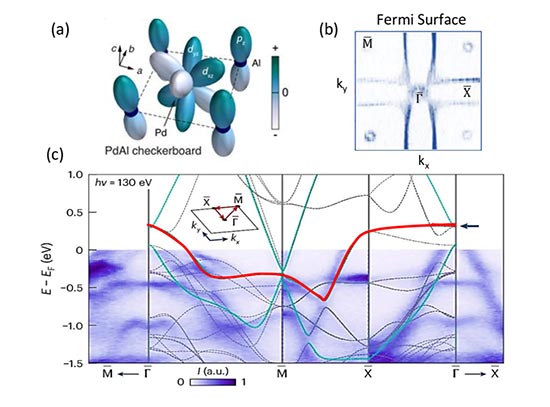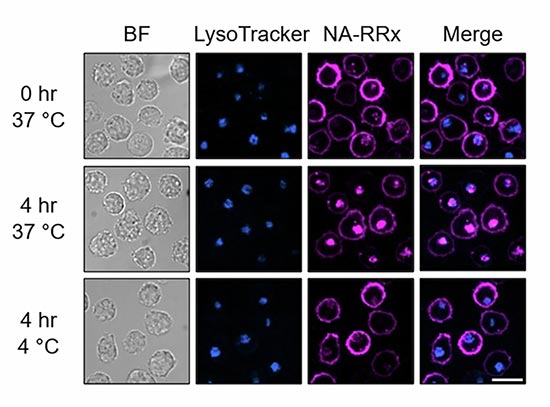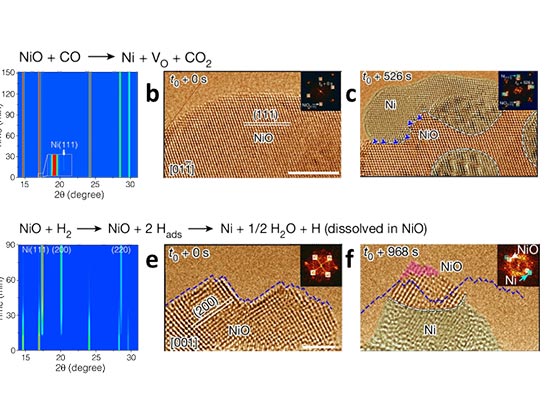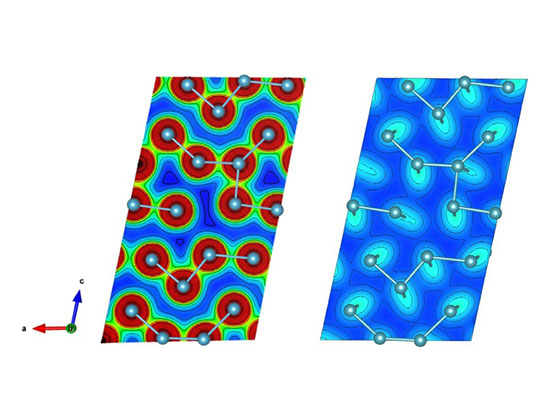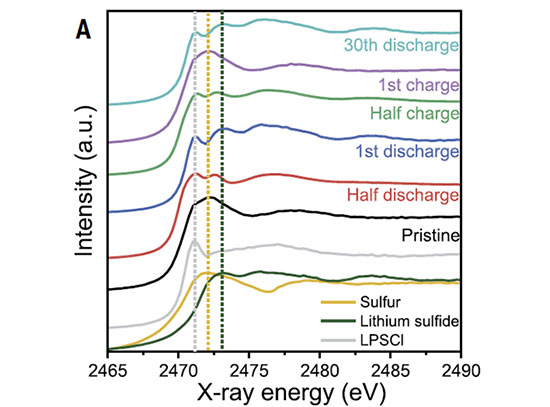Transporting and Storing Spins Non-Locally in an Antiferromagnet
Scientists show that, under strain, an exotic magnetic material can transmit spin
January 23, 2024
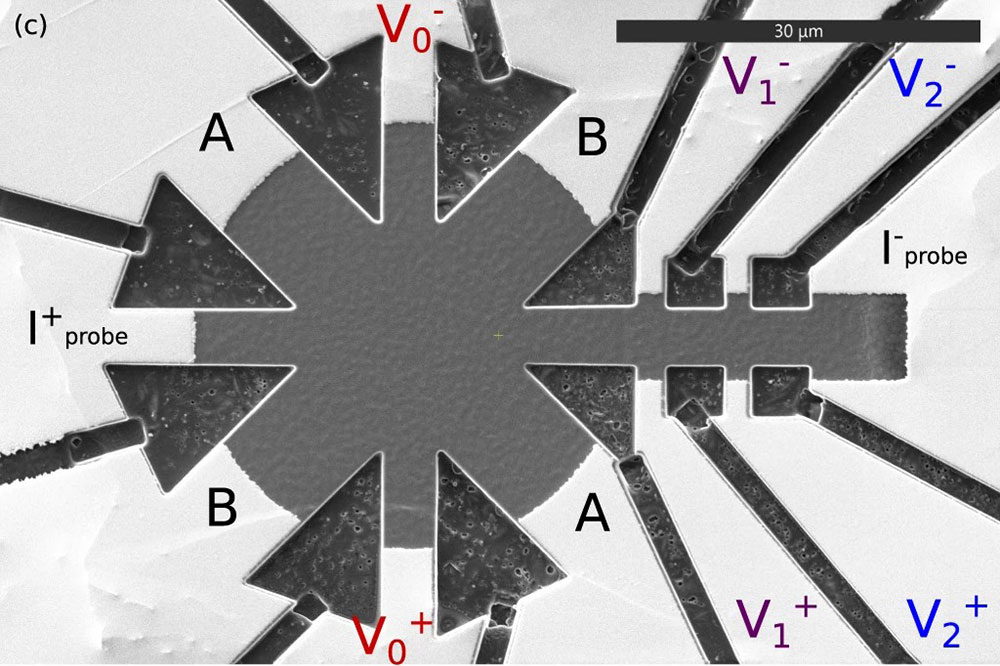 enlarge
enlarge
A switching device made from a bulk FexNbS2 crystal. The two pulse bars are marked A and B. The AC probe current is applied along the path marked Iprobe. The local signal is measured using the contacts labeled V0, and the non-local signals are measured using the contacts labeled V1 and V2. Image credit: S.C. Haley, E. Maniv, S. Wu, T. Cookmeyer, S. Torres-Londano, M. Aravinth, N. Maksimovic, J. Moore, R.J. Birgeneau, J.G. Analytis. Nat Commun 14, 4961 (2023)
The Science
Scientists demonstrate that electron spin information can be transported and stored non-locally in the FexNbS2 materials.
The Impact
These exotic magnetic materials could be candidates for the emerging field of antiferromagnet spintronics, a branch of quantum technology that could be the future of electronics.
Summary
Electronics that are based on an electron’s spin (and the associated magnetic moment) in addition to its charge, known as spintronics, could form the basis of many future technologies. Researchers are investigating a variety of materials for potential use in this emerging field, including antiferromagnets (AFMs), a class of magnetic materials characterized by arrangements of atoms with alternating spins. One potential application of this is spin-based computer memory. But first, scientists must be able to understand and even tailor the intricate magnetic, electronic, and spin behaviors of AFM materials.
A relatively new focus of this effort is the use of applied external stress, such as electric currents or heat, to induce or manipulate certain behaviors in AFMs by causing strain in the atomic lattice, which can, in turn, affect the magnetism. Scientists are wondering whether this “elastic” response can be used to induce desirable behaviors in AFMs.
One such family of AFMs being studied are the iron/niobium/sulfur (FexNbS2) compounds. These materials are interesting, in part, because they switch between resistance states when current pulses are applied in perpendicular directions. The effect can be very tunable depending on the amount of iron present. Previous studies have shown that the collective spin pattern of the material appears to play a role in this.
Now, a group of researchers has discovered a new feature of FexNbS2—When current pulses are applied, spin information can be manipulated non-locally, as far away from the current source as tens of microns (millionths of a meter). This is orders of magnitude further than the spin decay lengths of typical AFMs. It is an exciting finding, particularly with respect to possible future technologies.
To make this discovery, the group created a test device using single FexNbS2 crystals. The crystal structures were verified with high-resolution X-ray powder diffraction at the Pair Distribution Function (PDF) beamline at the National Synchrotron Light Source II (NSLS-II). NSLS-II is a U.S. Department of Energy (DOE) Office of Science User Facility located at DOE’s Brookhaven National Laboratory.
They studied the device’s performance in a few ways. These included using a very sensitive magnetometer to take magnetism measurements and a device called a medium frequency lock-in amplifier to study electron transport.
The group believes that the material’s elastic response only partly explains why the current pulses can affect spins so far from where the current was applied. They hypothesize that collective electromagnetic behaviors in the material play a role. Further studies into FexNbS2 may center on which collective modes might be involved as well as investigating other AFMs for switching behavior.
Download the research summary slide (PDF)
Contact
Shannon Haley
University of California, Berkeley
shannon_haley@berkeley.edu
James Analytis
University of California, Berkeley
analytis@berkeley.edu
Publication
Shannon C. Haley, Eran Maniv, Shan Wu, Tessa Cookmeyer, Susana Torres-Londono, Meera Aravinth, Nikola Maksimovic, Joel Moore, Robert J. Birgeneau, James G. Analytis, “Long-range, non-local switching of spin textures in a frustrated antiferromagnet.” Nat Commun 14, 4691 (2023). https://doi.org/10.1038/s41467-023-39883-7
Funding
This work was supported as part of the Center for Novel Pathways to Quantum Coherence in Materials, an Energy Frontier Research Center funded by the U.S. Department of Energy, Office of Science, Basic Energy Sciences. Work by J.G.A. was partially supported by the Gordon and Betty Moore Foundation’s EPiQS Initiative through Grant No. GBMF9067. The work by S.W. and R.J.B. was funded by the U.S. Department of Energy, Office of Science, Office of Basic Energy Sciences, Materials Sciences and Engineering Division under Contract No. DE-AC02-05-CH11231 within the Quantum Materials Program (KC2202).
2024-21742 | INT/EXT | Newsroom




